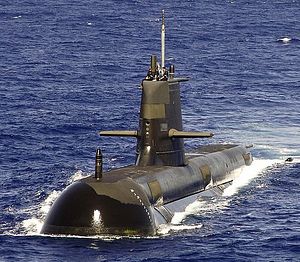Recently acquired by Swedish giant Saab, Kockums naval shipyards is facing a life-threatening challenge. It has been 20 years since its one and only export contract, the Australian Collins-class. The Swedish shipyard is hounded by the reputation of its product and 20 years of an endless ordeal.
Australian Defense Minister Christopher Pyne* is currently managing the renewal of the country’s submarine fleet, after 20 woeful years. The relatively small fleet of hunters has been plagued with such a flurry of technical and management problems that Australia has outright decided to re-brand the entire class, along with the change of models, with the unimaginative name: Attack-class. Tom Lewis, a former intelligence analyst for the Australian navy, writes “The Collins though wasn’t just a Swedish design assembled here. It was fiddled with; more capability was needed for one thing. It had to go further and stay there longer. And not having built submarines before – more complex machines than spaceships – we had a lot of problems.” And that’s putting it lightly.
An Australian audit reported that the entire program was beset with poor planning, lack of client-shipyard coordination, lack of performance vision, and poor craftsmanship from the builder Kockums. On the operator’s side, this resulted in immense reliability and performance problems. Put simply, the ships were seldom out in the ocean filling their purpose, but spent most of their time in drydocks being maintained. The Collins-class was deemed “louder than a rock band.” Military submarines base most of their defenses on stealth: With water carrying noise better than air, engineers around the world put a lot of work into making the moving parts of the ship as quiet as possible. With few or no possible counter-measures available in case the ship is fired at, the best chance of survival for a submarine is simply keeping the enemy from knowing it is there in the first place. The main sources of noise are generally the engine and the propeller (which causes cavitation). On both accounts, the performance of the Swedish subs was poor, leading to much Australian embarrassment.
At the root of the problem is a classic case of eyes bigger than stomach. Kockums, a small shipyard, has been tossed around between large mother companies (currently owned by Swedish defence giant Saab after German TKMS). While a small shipyard like Kockums is perfectly capable of building civilian submarines, such as those used for research or rescue, military submarine programs face an entirely new level of complexity, which few companies in the world are able to achieve. Civilian submarines face no challenges of range, autonomy, armament, stealth, countermeasures, or secured transmissions: They simply apply the submarine principle (which has been known for over a hundred years) and are built with modern material. In the end, overestimation of its own capacities and the failure to warn the Australians of what a challenge they were facing, had the best of the Collins program. Derek Woolner, a foreign affairs expert, writes: “Developing a unique submarine, in which most of the systems had unique specifications, guaranteed that there would be developmental problems. Continuing as though the program was a normal production run, with predictable outcomes within a fixed price contract, not only compounded the impact of difficulties when they did arise but had much to do with the persistence of performance problems and establishing the subsequent poor reputation of the submarines.”
Truth be told, the designing ideas which Kockums had come up with were nowhere near bad. The Swedes simply lacked the know-how to implement them. A glimmer of hope appeared in 2005 when ThyssenKrupp, one of the largest engineering companies in the word, acquired the Swedish shipyards. Successful submarines could have been the outcome, now that creative engineering ideas were joined with high-tech production capacities, but fate would eventually have it otherwise. In a woeful unravelling, which is still considered by some to have been Germany’s secret plan to run a competitor out of business with a false partnership, the alliance quickly went south and ended with a rare case of military repossession of state secrets by Sweden’s military.
The Kockums shipyard now faces a difficult situation. With no contract won since the Collins, the shipbuilder is in desperate need of fresh work. But the poor performance of the Australian submarine program now scares prospects away, especially since decades of idleness will wreak havoc on a workforce. With the inability to win new contracts on its own, the impossibility for Kockums to remain any longer without any new program to develop, and the risk of reuniting with former partner TKMS which almost sank Kockums, the future looks grim for the Swedish shipyard.
Saab, which has otherwise performed remarkably well in other types of armament programs, probably knows that Kockums’ fate was sealed years ago with the Collins-class submarine and is now facing one of two choices: Close completely or downsize drastically toward simpler civilian submarines, and restart from scratch.
*A previous version of this article misstated the name of the Australian defense minister.
Robert Green is a former mechanical engineer within Navy Strategic Command, Royal Australian Navy, and freelance writer.

































